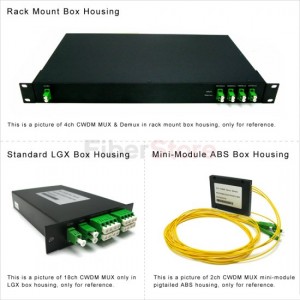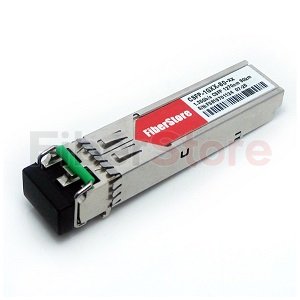The passive WDM network building block aggregates wavelengths of light from several transmitter sources, and transmits the combined these source light into one fibre. Each wavelength of light remains unchanged and transparent in the presence of neighboring wavelengths.
An optical prism represents a convenient way to understand a MUX/DEMUX function. When a multi-color light beam goes through an optical prism, due to its unique material property and geometry, light of different colors will exit at different angles,and become, in WDM terminology, de-multiplexed. Conversely, and become, in WDM terminology, demultiplexed. Conversely, designated angles, they will exit the prism at the same angle as a single light beam becoming, in WDM terminology, multiplexed.

The passive CWDM MUX building block can aggregates wavelengths of light from several transmitter sources(TX) and transmits the combined linght into one fibre. Eash wavelength of light remains unchanged and transparent in the presence of neighboring wavelengths. Typically, CWDM MUX and DEMUXE modules are designed with a minumum of 4 channels to a maximum of 16 channels.
CWDM Optical Add & Drop is the ideal solution for the increasing bandwidth demand on enterprise and metro access networks. ESCON, ATM, Fibre Channel, Gigabit-Ethernet are supported simultaneously, without disturbing each other. OADM is illustrated in a protedted ring system. OADMs provide access to a singel or even more wavelengths of a wavelength-multiplexed system increasing the possibility of networking. Although this greatly improves the flexibility for CWDM, the insertion loss of these devices poses a challenge on the design of rings as CWDM uses no optical amplitication to overcome losses.
In general, a CWDM (coarse WDM) MUX/DEMUX deals with small numbers of wavelengths, typically eight, but with large spans between wavelengths (spaced typically at around 20nm).
A DWDM (dense WDM) MUX/DEMUX deals with narrower wavelength spans (as small as 0.8nm, 0.4nm or even 0.2nm), and can accommodate 40, 80, or even 160 wavelengths.
The 100 GHz DWDM OADM is configurable as both an OADM and a terminal multiplexer and demultiplexer (MUX/DEMUX) to support a broad range of architectures ranging from scalable point-to-point links to four-fibre protected rings. The FS 100 GHz Optical Add/Drop Modules (OADM) offer a family of flexible, low-cost solutions to enable capacity expansion of existing fibre. FS 100GHz DWDM Optical Add/Drop (OADM) is designed to optically add/drop one or multiple DWDM channels into one or two fibres.
The compact transceivers are particularly uesful when operating on bidirectional linkes since each site comprises a transmitter as well as receiver, laser, receiver diode, and relevant electronices for driving the laser and shaping the received signal are integrated in a small form factor module with a standardized interface.
CWDM transceivers typically use directly modulated DFB lasers oprating at 2.5Gb/s and PIN receivers with a receiver module and decision circuit. The modulated output power ranges from 0 to 3 dBm, although it could be reduced at elevated temperatures since to activer cooling of the devices is avalible due to lower-cost design. The (PIN) receiver sensitivity of the transceivers is around to lower-cost design. The (PIN) receiver sensitivity of the transceivers is around-24…26dB so that a link budget of at least 24 dB should be available, which can be used to accommodate both the insertion loss of components (multiplexer fibre) as well as penalties due to the interaction of fibre dispersion and laser chirp. At lower bit-rates, the link budget is increasing up to 32dB at 1.25Gb/s.
FS wdm transceivers with embedded transmitter and receiver functions in a single packaged module. With different grades of performance,and have been integrated into WDM networks for point to point links, metro and core networks and storage area networks (SAN) applications such as data-centre mirroring.
FS supply 1.25Gbps (Gigabit) rate, 2.5Gbps rate, 4G rate and 10G rate CWDM & DWDM transceiver modules which enables use of CWDM/DWDM solutions for uncontrolled environment applications. CWDM transceivers can operate on 9/125um single-mode fibre to 40km or 80km by using special CWDM channels (1270nm to 1610nm, in steps of 20nm). Likewise, DWDM transceivers can supports a link length of up to 40km or 80km on single-mode fibre by using special DWDM channels ( 100GHz ITU Grid CH17 to CH61). All CWDM and DWDM transceivers from FS support DDM (Digital Diagnostic Management), and they are compliant with the Multi-Source Agreement (MSA) ensuring compatibility with a wide range of fibre optic networking equipment.
sfp tansceiver xfp transceiver
Other Building Blocks on FS
1G 2G 4G 10G Transponders ( OEO)
Transponders are usually used in some applications that the link length is much longer than what the power budget defines or there is not a clear line of sight between the two end nodes. OEO means optical-to-electrical-to-optical. It is one type of transponders. OEO converts optical signal to electrical signal and then to optical signal again. It allows for add-drop functionality, in addition to simple optical reply or transponder. FS supply 1G, 2G and 4G OEO, 125M~4.25G OEO Converter, 125M~1.25G OEO Converter, such as SFP to SFP Optical-Electrical-Optical type media converter / repeater to meet your different requirement.
10G OEO converter is used in Telecommunication room, R&D laboratory, Data centre or even 1310nm /1550nm/CWDM/DWDM Optical Wavelength Conversion. It supports multi-protocol 10G data rates including SDH/SONET STM-64/OC-192, 10G Ethernet, or 10G Fibre Channel. FS supply high quality 10G Transponder, such as XFP-XFP or SFP+ to XFP or SFP+ to SFP+ Optical-Electrical-Optical type media converter / repeater. They are for connection between fibre to fibre 10Gbps equipment function as fibre mode converter/repeater for long distance transmission.
For a complete listing of FS WDM products, refer to the latest guide on www.fs.com or contact us at sales@fs.com.



